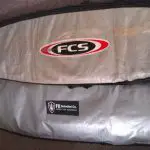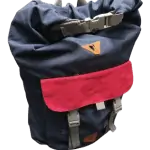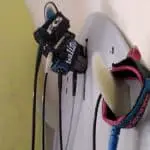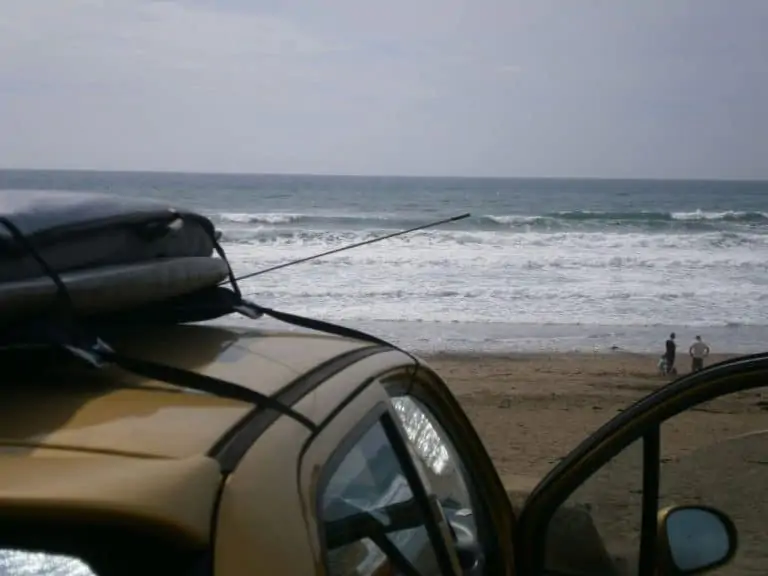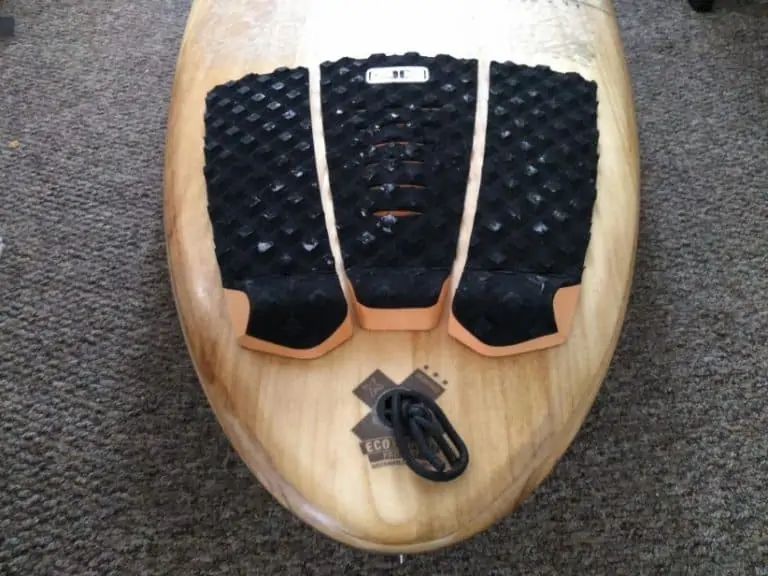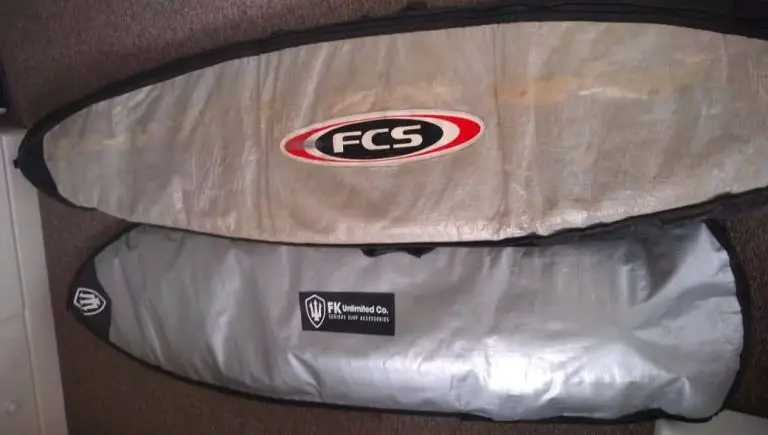Essential Surf Gear: ONLY What You Need to Get Started (No BS)
Getting the right gear for surfing is a an absolute must for you to have fun and maybe even keep doing it into the future.
Unfortunately, there are a lot of websites online that try to tell new surfers that there are lots of things you should buy to start surfing that are actually not necessary. For instance, learner surfers don’t need the latest tide watch or GoPro to get started – they just need a few essential items that will help them decide whether surfing is for them.
So, what gear do you need for surfing? This obviously starts with a surfboard but, from there, you will need a wetsuit or surf clothing to match the water temperature, a leash, surf wax, something to carry your wetsuit in and a few other items as we’ll look at below.
Right board
An ideal learner surfboard is one that is 2 feet longer than you are tall, has a foam construction, is wide in the nose and the tail, is nice and thick, and has a good amount of volume.
The length of your surfboard when learning is crucial to giving you the most enjoyment and best chance of progressing steadily.
The longer a surfboard, the more surface area on the water, making it more stable when you stand up, easier to catch waves and more forgiving for a learner.
If you are buying for a younger learner who still has plenty of growing room, then you might consider going for a surfboard with a bit more length to allow for their growth in future. Again, this depends on how often you think they will go; if surfing is likely to be a regular thing for them, then get a board that allows for progression, but if it’s probably only a one-off or similar then you might just be better off hiring a board at the beach from a surf school or store.
However, there is a limit to this length guide; if you get a learner surfboard that is much longer than your height plus 2 feet then you might find that it becomes so big that you cannot carry it easily and it is actually too heavy for you.
To give you an example, I am 6’0 and 175 pounds (on a good day!) but I can barely carry my wife’s 9’0 longboard! This makes me struggle to get it into the water and puts me off using it (well, it actually isn’t mine but you get the idea!). My wife is also quite petite, at 5’3 and 100 pounds, so she almost always needs my help to get it down to the beach.
Comfy wetsuit
By comfy, what I really mean here is that your wetsuit is both a good fit and has the right thickness.
Getting a wetsuit with a good fit will mean that you enjoy using it and that it allows you to move properly out in the surf. It will also keep you warm and help you to start out in the surf for longer, giving you more time to catch waves and actually learn to surf.
If a wetsuit is too tight, it will not last long and could break at any moment, as well as possibly making it hard for you to breathe if tight around the neck.
If it’s too big, then it simply won’t keep you warm out in the surf and defeats the object of having a wetsuit.
However, my strong advice for you buying a first wetsuit is that you don’t buy online if it’s the first time and, instead, go to a store where you can try the wetsuit on.
This will help you to see which brand of wetsuit fits your body’s shape best (since they are all cut a little differently) and you can also get advice on which one to choose from the person in the store, something which you can’t really get online. You can see more on this in my video below and remember, for more helpful videos like this, subscribe to the Surf Learner YouTube channel!
In terms of wetsuit thickness, a 3/2mm wetsuit should be fine for summer in most areas, although in water temperatures above 66°F you can surf in boardshorts and a t-shirt or rash guard. If surfing in water below 60°F, then definitely check out this detailed post about choosing the right wetsuit for you (scroll down to see the table under heading ‘Think: Location, location, location’).
Right Leash
To be clear, a leash is the attachment and cord that you strap on to your leg and connects you to your board at all times, for which reason Australians often call surf leashes a ‘leg rope’.
This is an essential item of surf safety gear for both you and for other surfers. Remaining attached to your surfboard at all times means that you can fall off and not have to worry about the board washing in to shore each time.
It also means that your board is less likely to hit other people as it will not go further than the length of the board plus the length of the leash.
So, the right leash is as long as your surfboard, or a little longer, is new, and not a ‘comp leash’ as these are weaker and not suitable for learner surfboards.
If in doubt on the length of a leash, just round up to the next foot; having a leash that is up to 1 foot longer than your surfboard is absolutely fine and is better than having one that is too small.
The reason why I say that a new leash is important is because the Velcro on older leashes can wear out after several years of use. I’ve found this out the hard way when surfing (and living) in Indonesia for several years where the waves are extremely powerful; my leash kept coming off from the sheer force of the waves after several months of heavy use, which is something you definitely want to avoid!
Now, in most learner spots, a good leash should last many years but just be mindful if buying a used surfboard that comes with a leash since the leash they give you might be really old and not have much life left in it.
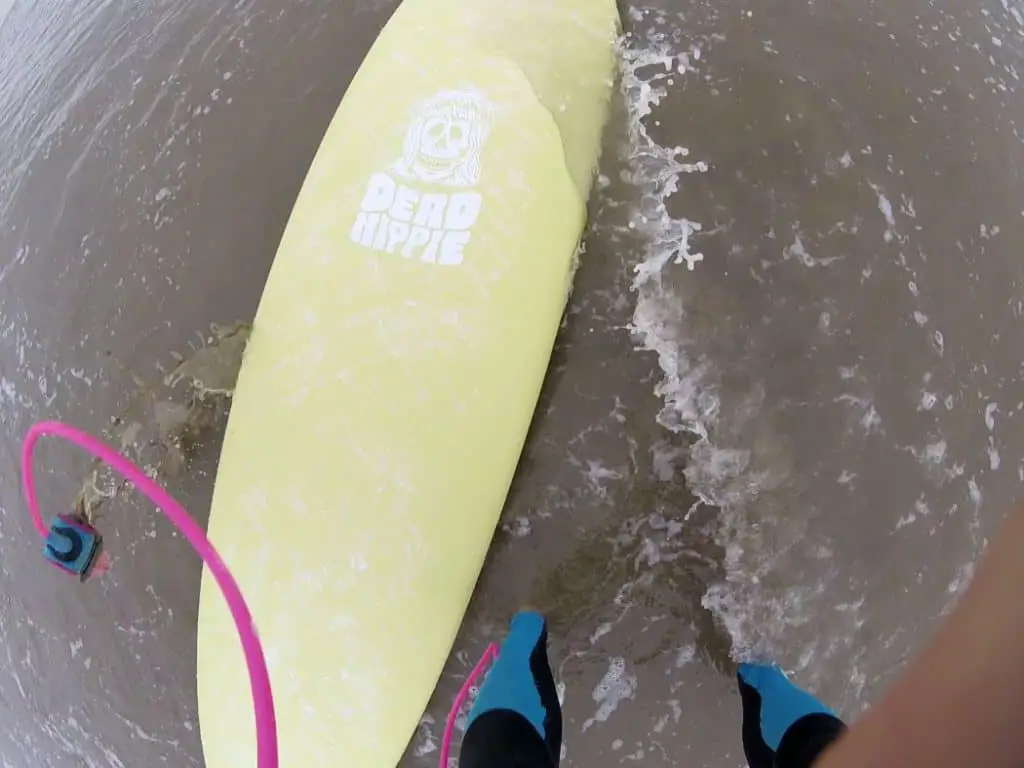
Surf Wax and Scraper
An essential for all surfers is wax as this keeps you from slipping off your board and gives you the necessary grip when both lying and standing on your surfboard.
Without wax for grip, your surfboard’s surface will become as slippery as ice the moment it gets a drop of water on it.
Fortunately, surf wax is both cheap and readily available, so you can stock up on these easily and buy them online without any worries.
Just be sure to buy the right wax to match the temperature of the water that you are going to be surfing in. All surf wax comes with a temperature guide so you can see that either on the label or on the product description on their website.
Remember to reapply wax as needed since it doesn’t stay grippy for that long, although there are more tips on this below.
As an extra tip, some surf stores both in person and online might throw in some wax free with your purchase, so be sure to check out whether they offer these when buying, or at least ask about what wax they recommend in the store to see what they say!
Are there Alternatives to Surf Wax?
Well, yes, there are alternatives to surf wax but the other options are just not as easy or cheap to use, hence I wrote surf wax was an essential above, not least because you will still probably need some whatever grip option you choose.
You can look into going for a full deck of traction pads but definitely read my article on pads before deciding on doing that or not!
As for the new grip stickers you can buy from brands likes HexaTraction, you can get these in place of wax but I have not used them so cannot really say how they compare to wax; my feeling is that they are probably very hard to put on perfectly and might well come off after a few surfs, but the jury is still out on that one so I’ll leave it with you.
Wax Scraper
To go with your surfboard wax, get yourself a wax scraper, also called a ‘wax comb’ outside of North America.
A wax scraper is made of hard plastic and has a flat ruler-edge for scraping off your wax as well as a comb with teeth for giving more grip to your existing wax.
This simple bit of hardware will mean that you can get more life out of your wax by roughing it up to give it some grooves and extra traction.
You can also use the flat edge for scraping off wax when it comes time to change. This might be because of the changing water temperature with the seasons or simply because your wax is starting to look old and dirty (which definitely does happen!).
Waterproof SPF30+ Sunscreen
Spending long hours out in the ocean while surfing is intense for your skin since the sun’s rays reflect and bounce off the water straight onto your skin.
This is most noticeable around the face, so make sure that you cover and protect yourself from this. You really don’t want to be totally frazzled after just a few hours in the surf as it’s an intense hit of UV for anyone.
As such, I’d recommend getting a high-quality zinc-based sunscreen, effectively a full sunblock that says it’s suitable for surfing. Most sunscreen products say that they are suitable for swimming, but that is not enough since surfing demands a more robust protection than just swimming, so be clear to look for this specifically.
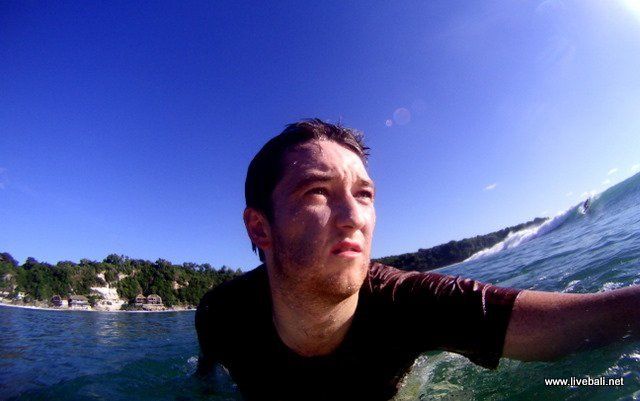
You can also opt for the organic products available but be sure to read what claims they make around sun protection and effectiveness. I know that I used an organic sunscreen product when I was in Bali and it worked fine for me, but just be sure to read up and see what claims they make about their levels of protection.
Wetsuit Tub or Bag
A wetsuit is a pretty ugly thing to have to carry when wet. Not only will it be much heavier than usual but it will also be dripping and cause just about anything it touches to get damp very quickly.
As such, getting yourself a wetsuit tub or bag can save you from getting salty tide lines on other bags, and even your car’s upholstery! It will also keep everything else dry and let you carry your wetsuit to and from the beach with ease.
For the budget wetsuit carrying option, a tubtrug of 6 gallons or more (Amazon affiliate link) is absolutely fine and easy for carrying your wetsuit. You can just sling all your gear in and away you go. These are made of a durable plastic and will last for years; my current tub is about 8 years old and going strong!
For a wetsuit bag, I’d specifically recommend the Vissla Surfer Elite backpack as this is the bag I bought for both myself and my wife.
This is because it is an extremely sturdy wetsuit bag that will hold all of the gear that you need, including full winter wetsuit gear if you get the large version of this bag.
In fact, you can see my wife’s YouTube video review of this wetsuit bag below:
Large Towel or Changing Poncho
So, when at the beach you will need a large beach towel or changing robe to keep your dignity when getting in and out of your surf gear!
You will probably already have a large beach towel, so there’s not much to explain there other than that the bigger this is, the easier it is to get changed with. Men can get away with a smaller towel but remember that it just makes the task a little more tricky; as for women, a standard size towel is probably a bit of a push so going for an extra large beach towel is recommended.
However, as an alternative to a beach towel, you can get a changing robe that is designed specifically for getting in and out of the surf.
I really like the poncho option as it makes changing that bit easier than with a towel and is great for extra warmth and protection from the wind in winter, too.
These also have a hood that starts to dry your hair as you change, too, so pretty cool!
In terms of recommending a surf changing poncho, I’d say go for the Ho Stevie! Surf poncho over on Amazon as it has great reviews and is a brand run by an avid surfer who is always testing the hardware before putting it to market.
Rashguard
If you are not familiar with rash guards, these are tight tops worn by people in most watersports and are made of mostly polyester with spandex for stretch. Although they were first designed to keep wetsuits from chafing on the user’s skin, they now have many more and wider uses and are an inexpensive and essential item of surf gear.
These rashguards offer sun protection so you can wear them as a top if out surfing in warm water.
If going in cold water, they also add a layer under your wetsuit that can be good for both giving a little extra warmth and from preventing any chafing (although good quality wetsuits shouldn’t have that issue!).
It also feels nicer putting a wet wetsuit on with a rashguard since they dry quickly and can reduce the horrible feeling of a wet wetsuit, which is just like putting on wet clothes and feels all kinds of wrong!
Although a simple surf accessory, I would still recommend getting a rashguard by a known surf brand as they functionality in these will always be better than the random brands you might see on sites like Amazon.
Waterproof Key Holder
If you are carrying a car key with you, you will definitely need a waterproof key holder since your electronic car key will not last one surf without being destroyed if you take it in the water!
Not only is water damaging for electronics, as you obviously know, but also the salt in seawater makes it corrosive, so it will also quickly destroy the components inside the key if the water somehow doesn’t short circuit the electronics inside first time!
It’s also just dangerous to stash your keys somewhere since thieves have learned to watch surfers as they know that a surfer usually goes out into the waves for a long time, making a surfer’s car an easy target, so there’s no need to make it even easier for them by leaving your keys around at the beach!
I’ve been through a few different key options, including a locking box designed for surfers, but by far the best I’ve found is a simple waterproof key pouch.
The one I use is the Aquapac NRS Keymaster (Amazon affiliate link) which has been brilliant for me and has lasted 8 years so far.
I just put it down the back of my wetsuit before heading out into the surf and pretty much forget about it. It took a little getting used to at first but after doing it a few times you won’t even notice it.
Before I had the Aquapac, I actually bought a surfer’s lockbox but that was not great since the mechanism got sandy and I didn’t really trust a simple combination lock to keep my car secure. If thieves can see a combination lock that they think might have your keys in then it’s a pretty appealing target, hence I stopped using the surfing lockbox after just a few outings because it just never felt safe enough for me.
Rack to Hang Your Wet Wetsuit!
When you get home after a surf, you’re going to need some way of hanging your wetsuit if you want it be even close to dry the next time you go surfing!
There are lots of wetsuit hangers available on sites like Amazon with good reviews, so these could be good if you have somewhere sturdy to hang them on. I say sturdy since a wet wetsuit weighs a lot more than when it’s dry, so you can’t just hang it up anywhere.
However, my recommended option is for a foldable stainless steel clothes drying rack, like this one on Amazon by Sunbeam with excellent ratings.
The beauty of this kind of rack for your surfboard is that it is cheap, functional and folds away when not in use. And of course, you can use it for your laundry too so it’s not just an extravagant bit of surfing gear!
Add to that the fact that you can hang other items like your rashguard and even wetsuit boots or gloves on it and you can immediately see the benefits of a rack like this.
We live in an apartment with a small bath and the rack we have, although not the one above, actually fits inside the bath so we can leave our suits to drip dry in there overnight, which is pretty handy.
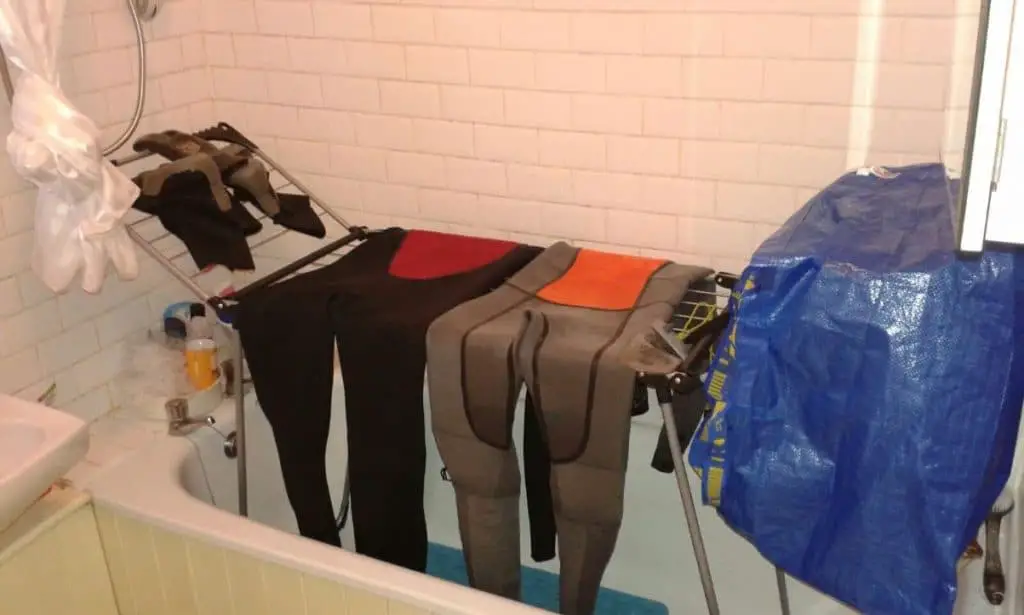
Related Questions
Do you need water shoes for surfing? No, you don’t. This is because water shoes are not designed for sports like surfing and will cause you to fall on your surfboard. However, you can get specialist surfing booties that will help but these are either for rocky beaches or cold water.
If you are looking at surfing at a rocky beach, then it’s probably not the best spot for you to learn to surf since a sandy bottom is by far the safest place to learn.
If you are planning on surfing in colder water then you will need to spend quite a lot on a good wetsuit and all the accessories, so think about taking a surf lesson in that area to see what gear they offer you before buying any accessories or surf gear. This should save you time and money and mean that you only get exactly what you need.
What can I use instead of surf wax? You can use either a traction pad or a HexLite grip sticker. Traction pads, also called ‘stomp pads’ are made of foam and need to be glued onto your board. If done correctly, this should last the lifetime of your surfboard.
The grip stickers are a newer innovation and should also last a similar amount of time to traction pads, however they are a little bit harder to put on properly so the chances of them coming off are higher.
